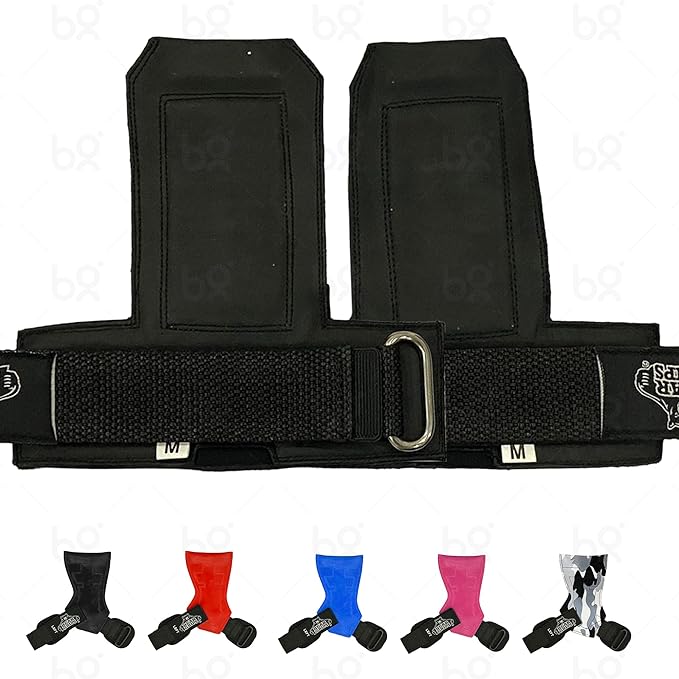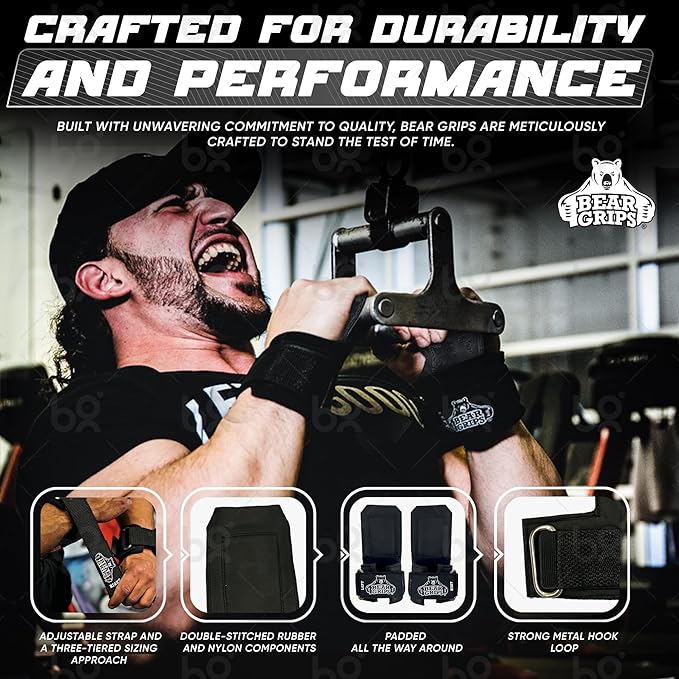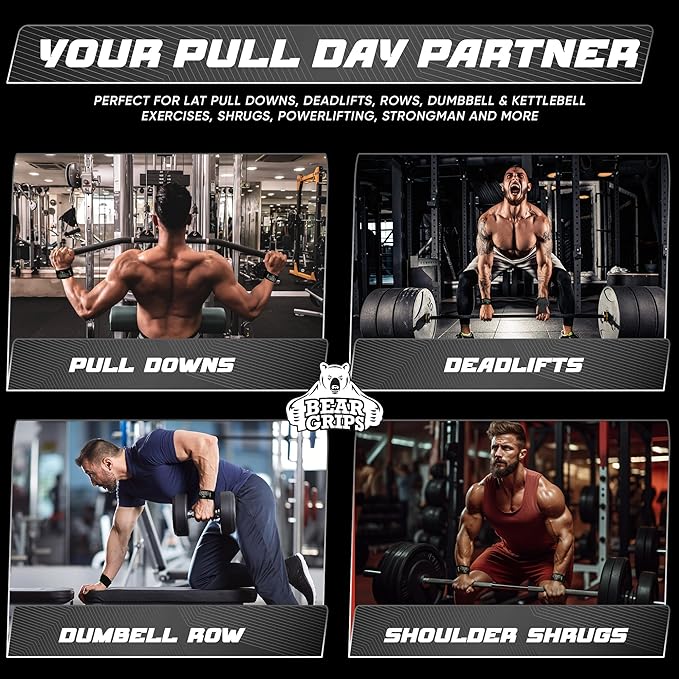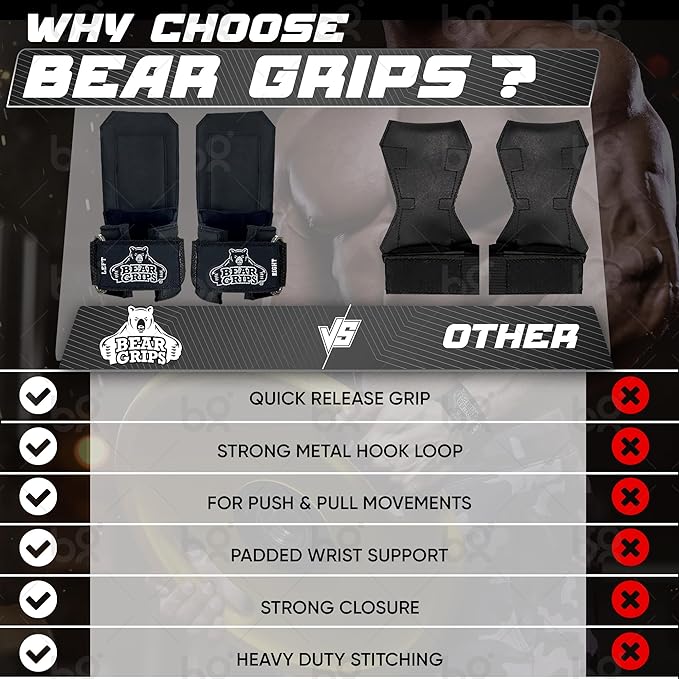
Lifting Straps How to Use: A Complete Guide
Share
Lifting straps are a valuable tool for weightlifters and athletes who want to enhance their grip strength and improve their weightlifting technique. They are long pieces of material, usually made of nylon, leather, or cotton, that are wrapped around the wrist and fastened to a barbell or other gym equipment.
There are different types of lifting straps, including closed-loop, lasso, and figure-8 straps, each offering different levels of security and versatility. Lifting straps provide benefits such as a secure grip, the ability to lift heavier weights, support during high-rep and big-volume workouts, palm protection, and the ability to focus on proper technique.

They can be used for various exercises, but it's important to know when to use them and to gradually incorporate them into your training routine. To use lifting straps properly, you need to choose the right type of strap for your needs, put your hand through the loop, wrap the strap around the bar, and perform the exercise with a secure grip.
Key Takeaways:
- Lifting straps enhance grip strength and improve weightlifting technique.
- They come in different types, including closed-loop, lasso, and figure-8 straps.
- Lifting straps provide a secure grip, the ability to lift heavier weights, and palm protection.
- Proper technique and gradually incorporating lifting straps into your training routine are essential.
- Choose the right type of strap for your needs and use a secure grip for optimal results.
What Are Lifting Straps?
Lifting straps are essential accessories for athletes looking to improve their grip during weightlifting exercises. Made of various materials like nylon, leather, or cotton, lifting straps come in different types to suit different needs and exercises.
- Closed-Loop Straps: Closed-loop straps are the most basic option. They consist of a loop with two ends sewn together, providing a simple and convenient way to secure the strap to the bar or handle.
- Lasso Straps: Lasso straps offer more versatility. They feature a loop for the wrist and one loose end that can be wrapped around the bar or handle. This design allows for easy adjustments to accommodate different grip widths.
- Figure-8 Straps: Figure-8 straps provide the highest level of security. They have two large loops that fasten the wrists tightly to the bar or handle, ensuring an extremely secure grip. This type of strap is popular among powerlifters and those lifting heavy weights.
Each type of lifting strap has its own advantages and is suitable for different exercises and athletes. The choice depends on personal preference, the specific exercise, and the desired level of grip security.
What Do Lifting Straps Do?
Lifting straps offer a variety of benefits to athletes, helping them overcome common challenges and enhance their lifting performance. Here's what lifting straps can do:
- Secure Grip: Lifting straps provide a reliable grip, preventing the bar from slipping out of your hands. This is particularly valuable for athletes who struggle with grip strength or have experienced accidents due to a weak grip.
- Ability to Lift Heavier Weights: By using lifting straps, athletes can increase their lifting capacity. The straps provide support and reduce the strain on the forearms, allowing individuals to lift heavier weights and push their limits.
- Support for High-Rep Workouts: During high-repetition workouts or big-volume workouts, fatigue can affect the grip, making it challenging to maintain a secure hold on the bar. Lifting straps offer the necessary support, enabling athletes to focus on their form and complete their workouts effectively.
- Palm Protection: The knurling on bars can be abrasive on the hands, leading to calluses or torn skin. Lifting straps offer palm protection, minimizing the impact of knurling and allowing athletes to continue training without discomfort or interruptions.
- Facilitates Proper Technique: One of the key benefits of lifting straps is that they eliminate distractions caused by sore forearms or a slipping barbell. This enables athletes to concentrate on maintaining proper technique, leading to better form, improved performance, and reduced risk of injuries.
- Beneficial for Small Palms: Athletes with small palms or short fingers often struggle to maintain a secure grip, especially when dealing with thick bars. Lifting straps provide a more secure grip, allowing individuals with small palms to overcome this challenge and lift with confidence.
Overall, lifting straps are a valuable tool for athletes seeking to optimize their lifting performance. They provide enhanced grip strength, support for heavier weights, and palm protection, all while facilitating proper technique. Whether you're a beginner or an experienced lifter, incorporating lifting straps strategically into your training routine can help you take your lifting to the next level.
When to Use Lifting Straps?
Lifting straps are a valuable tool for athletes performing pulling exercises such as deadlifts, Olympic pulls, snatches, cleans, and pull-ups. They can also be used with dumbbells, kettlebells, and exercises that require holding weights for an extended period, like the farmer's walk. Lifting straps provide additional support to the grip, allowing athletes to focus on their target muscles and perform the exercises with proper form. However, it is crucial to know when to incorporate lifting straps into your training routine.
For beginners, it is generally recommended to develop adequate grip strength before relying on lifting straps. Building grip strength is important for overall strength and stability. Beginners should prioritize exercises without the assistance of lifting straps to strengthen their forearms and grip. Using straps too soon may hinder the development of grip strength, which is essential for long-term progress.
Athletes with upper-limb injuries can benefit from using lifting straps to reduce strain on the injured area. By utilizing lifting straps, they can continue their training while minimizing further damage and promoting recovery. However, it is crucial to consult with a medical professional or physical therapist to ensure safe usage and proper rehabilitation.

It is important to gradually incorporate lifting straps into your training routine rather than becoming overly dependent on them. Strive to strike a balance between using lifting straps for specific exercises or challenging sets and gradually increasing grip strength through regular training sessions without the assistance of straps. This approach will help improve overall strength, stability, and grip endurance.
Exercises Suitable for Lifting Straps
| Pulling Exercises | Dumbbells/Kettlebells | Other Exercises |
|---|---|---|
| Deadlifts | Farmers Walk | None |
| Olympic Pulls | Single-Arm Rows | None |
| Snatches | Overhead Carries | None |
| Cleans | Loaded Carries | None |
| Pull-ups | None | None |
When to use lifting straps ultimately depends on your grip strength, specific training goals, and any underlying injuries. It's important to use them strategically to enhance your training experience while continuing to develop your grip strength naturally.
Reference:
Edwards, T., Vishnyakov, N., & McMaster, D. T. (2019). The optimal training load for the development of dynamic muscular endurance in trained individuals: a systematic review and meta-analysis. Journal of Science and Medicine in Sport, 22(8), 896-901.
How to Use Lifting Straps?
Using lifting straps correctly is essential for maximizing their benefits. The steps for using lifting straps may vary depending on the type you choose, such as closed-loop, lasso, or figure-8 straps.
Closed-Loop Straps
To use closed-loop straps:
- Put your hand through the loop.
- Wrap the strap around the bar.
Lasso Straps
To use lasso straps:
- Put your hand through the loop.
- Wrap the loose end around the bar.
Figure-8 Straps
To use figure-8 straps:
- Place your hand through two loops.
- Secure them tightly around the bar.
It's important to follow the specific instructions for each type of strap to ensure a secure and comfortable grip.
Recommended Lifting Straps: Bear Grips Lifting Wrist Straps
When it comes to lifting straps, finding a reliable and versatile option is crucial for athletes who want to enhance their grip during workouts. One highly recommended choice is the Bear Grips Lifting Wrist Straps.
These lifting straps are made of durable cotton material and feature neoprene padding for added comfort during your weightlifting sessions. The double stitching and high-quality construction of these straps ensure they can withstand up to 350 kg, providing the security and support you need.
The cotton material used in these lifting straps is not only soft on the hands but also absorbs sweat effectively, preventing the bar from slipping. This feature allows you to maintain a secure grip throughout your workouts, even during intense lifting sessions.
With the Bear Grips Lifting Wrist Straps, you can trust in their reliability and durability to enhance your grip and optimize your performance in the gym.
Are Lifting Straps Worth It for Beginners?
When it comes to beginners, developing grip strength is a crucial aspect of their fitness journey. Strengthening the forearms and grip through exercises without the assistance of lifting straps is generally recommended. This allows beginners to build overall strength and stability while gradually improving their grip.
However, there are cases where beginners may struggle with grip strength or experience discomfort during certain exercises. In such situations, incorporating lifting straps can be considered as they provide additional support and stability. It's important to strike a balance and not rely excessively on lifting straps, as it may hinder grip strength development in the long run.
By focusing on gradual progression and incorporating lifting straps selectively, beginners can enhance their training experience while still prioritizing the development of grip strength. Remember, lifting straps should supplement, not replace, the natural development of a strong grip.
Is it Okay to Deadlift with Straps?
Using lifting straps for deadlifts is generally acceptable and can provide support for heavy lifts. However, it's important to note that in powerlifting competitions, the use of lifting straps is not allowed. Athletes competing in powerlifting should refrain from using lifting straps in the weeks leading up to a competition to ensure they are capable of performing without them.
On the other hand, lifting straps can be used in some strongman competitions, where grip strength is less emphasized. Athletes should consider the rules and regulations of the specific competition they are participating in when deciding whether to use lifting straps.

Pros and Cons of Using Lifting Straps
Using lifting straps can have both advantages and disadvantages, depending on your fitness goals and individual circumstances. It's important to weigh the pros and cons before incorporating lifting straps into your workout routine. Here are the main benefits and drawbacks to consider:
Pros of Using Lifting Straps:
- Improved Grip Strength: Lifting straps provide a secure grip, allowing you to focus on the target muscles without worrying about your hold on the weights. This can be especially beneficial if grip strength is a limiting factor for you.
- Increased Lifting Capacity: By reducing the strain on your forearms and grip, lifting straps can help you lift heavier weights and push your limits during strength training exercises.
- Enhanced Safety: Lifting heavy weights without a secure grip can be dangerous. Lifting straps offer added safety during heavy lifts, reducing the risk of dropping the weights and causing injury.
- Reduced Risk of Muscle Imbalances: If one hand is stronger than the other, it can lead to muscle imbalances. Lifting straps can help even out the load between both sides, promoting balanced muscle development.
Cons of Using Lifting Straps:
- Decreased Grip Strength: Overreliance on lifting straps can lead to decreased grip strength over time. It's important to strike a balance and continue incorporating exercises that strengthen your grip.
- Discomfort for Some Individuals: Lifting straps may feel uncomfortable or restrict movement for certain individuals. It's crucial to find straps that fit properly and do not cause discomfort during workouts.
- Potential Overuse: Using lifting straps for every exercise can hinder the development of your grip strength. It's important to utilize them strategically and not become overly dependent on them.
Ultimately, the decision to use lifting straps should be based on your specific needs and goals. If you struggle with grip strength or want added support during heavy lifts, lifting straps can be a valuable tool. However, it's important to use them in moderation, focus on proper technique, and continuously work on improving your grip strength to maintain overall strength and stability.
Conclusion
Lifting straps are an invaluable tool for weightlifters and athletes seeking to improve their grip strength and enhance their weightlifting technique. These straps provide numerous benefits, including a secure grip, the ability to lift heavier weights, support during high-repetition and high-volume workouts, and palm protection. When using lifting straps, proper technique is crucial, and it is essential to select the appropriate strap type for your specific needs.
While lifting straps can be advantageous for both beginners and experienced lifters, it is important to use them in moderation and not rely solely on them. Developing grip strength should still be a priority, and incorporating lifting straps strategically into your training routine can maximize their benefits. By following the correct techniques and gradually incorporating lifting straps into your workouts, you can improve your overall performance and achieve your fitness goals more effectively.
In summary, lifting straps are a powerful tool that can help you take your weightlifting to the next level. With their ability to provide a secure grip, allow for heavier lifts, and offer support during intense workouts, lifting straps are an essential accessory for any serious lifter. By using them in conjunction with proper technique, you can optimize your training and experience the many benefits that lifting straps have to offer.
Get yourself high-performing lifting straps and increase your workout results. Check out Bear Grips right today!
Shop at Amazon.com Now!
FAQ
What are lifting straps?
Lifting straps are long pieces of material, usually made of nylon, leather, or cotton, that are wrapped around the wrist and fastened to a barbell or other gym equipment.
What types of lifting straps are there?
There are different types of lifting straps, including closed-loop, lasso, and figure-8 straps, each offering different levels of security and versatility.
What do lifting straps do?
Lifting straps provide benefits such as a secure grip, the ability to lift heavier weights, support during high-rep and big-volume workouts, palm protection, and the ability to focus on proper technique.
When should I use lifting straps?
Lifting straps can be used for various pulling exercises such as deadlifts, Olympic pulls, snatches, cleans, and pull-ups. They can also be used with dumbbells or kettlebells, as well as exercises that require holding a weight for a prolonged period, like the farmer's walk.
How do I use lifting straps properly?
To use lifting straps properly, you need to choose the right type of strap for your needs, put your hand through the loop, wrap the strap around the bar, and perform the exercise with a secure grip.
Are there any recommended lifting straps?
One highly recommended option for lifting straps is the WARM BODY COLD MIND Lasso Lifting Wrist Straps. These straps are made of cotton and feature neoprene padding for added comfort.
Are lifting straps worth it for beginners?
Beginners should wait until they have developed adequate grip strength before incorporating lifting straps into their workouts, but if they struggle with grip strength or experience discomfort, they can consider using lifting straps for certain exercises.
Is it okay to deadlift with straps?
Using lifting straps for deadlifts is generally acceptable and can provide support for heavy lifts, but in powerlifting competitions, the use of lifting straps is not allowed.
What are the pros and cons of using lifting straps?
The benefits of using lifting straps include improved grip strength, increased lifting capacity, enhanced safety, and reduced risk of muscle imbalances. However, overuse of lifting straps can lead to decreased grip strength, and they may be uncomfortable for some individuals.
How do I conclude on lifting straps and their usage?
Lifting straps are a valuable tool for weightlifters and athletes looking to enhance their grip strength and improve their weightlifting technique. By using them properly and in moderation, you can maximize their benefits and improve your overall performance in the gym.

